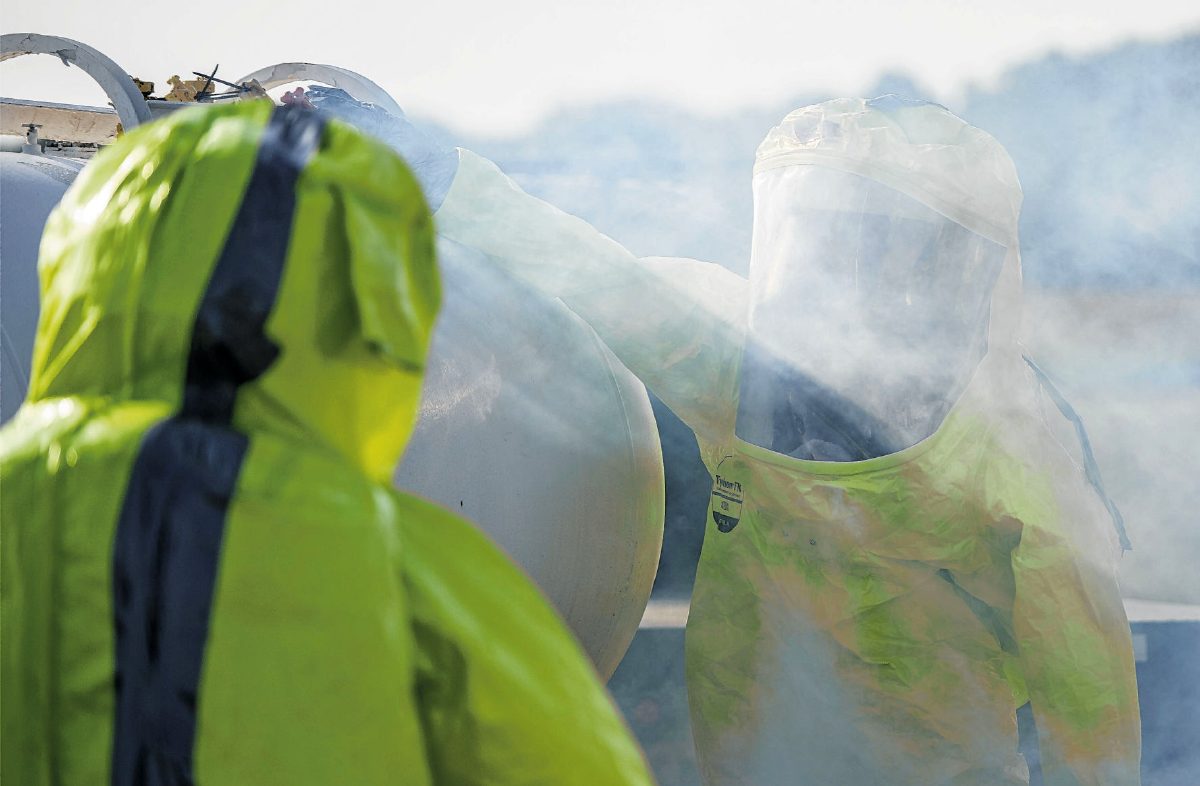
The disaster played out like it was real.
A Nineveh-Hensley-Jackson school bus was parked next to tanks of anhydrous ammonia behind Indian Creek High School.
Two Indian Creek High School students crawled under the bus to play deceased victims of the crash. The bus driver slumped over in the seat to be a deceased victim too, while a fog machine sent vapor into the air to simulate ammonia escaping the tanks.
[sc:text-divider text-divider-title=”Story continues below gallery” ]Click here to purchase photos from this gallery
Minutes later, emergency sirens were heard in the distance as first-responders from as far away as Greenwood received the dispatch that some smoke, fog or chemical was being released at Indian Creek High School and that there was a bus accident.
The scenario proved an opportunity for the entire community to practice in case a similar tragedy were to ever occur. Johnson County’s Local Emergency Planning Committee conducted a disaster testing scenario at the school on Tuesday, preparing first-responders, county agencies and school officials in the case of an emergency dealing with dangerous chemicals.
Many businesses in the county have hazardous chemicals on site, which made the exercise necessary, Johnson County Emergency Management Department Director Stephanie Sichting said. Every business that stores or uses chemicals considered hazardous pay a fee that goes back to the county to help pay for emergency training.
A consultant was hired for $12,000 to set up the scenario. The local emergency planning committee received a state grant that covers all but $2,000 of the consultant’s cost, Sichting said.
Committee members worked through this scenario last year on paper and decided to try the same scenario live, Sichting said.
The state requires the committee to test their communications and strategies during a disaster periodically. On Tuesday, a representative from the state’s Department of Homeland Security was at the scene to evaluate. Those who were not involved in the testing, such as other school bus drivers, lined up at the scene to see how it would play out.
Firefighters from Trafalgar arrived first just after 9 a.m. and checked the pulses of the students that were under the bus. They found the cards that told them that they had died from the accident.
They then moved onto the bus from the back doors, where stretchers were brought in to get the students playing injured victims off the bus, on a stretcher and in some cases, into an ambulance.
Some firefighters carried some of the teens to safety by their arms and legs and in one case, by bear-hugging a teen and carrying him off the scene.
In all, the roughly two dozen students who were playing survivors were evacuated from the bus in about 15 minutes, Sichting said.
Greenwood’s hazardous materials team arrived and began dealing with the ammonia tanks, while evaluators across multiple departments took notes on what their employees did well and what they could have improved on. Inside the school, parents were looking for teddy bears with the name of their child on them to test the school’s protocol on getting students to their parents after a disaster.
Evaluators were making sure their department handled details of the scene correctly. For example, Brad Coy, assistant fire chief for Greenwood, was checking the hazmat team for a check list of details, such as whether they washed their suits to clear them of chemicals before returning to the truck and how they handled the tanks after the leak.
First-responders from Trafalgar fire and police departments, the Johnson County Sheriff’s Office, Greenwood’s hazmat team, the Johnson County Health Department and Nineveh Fire Department were all apart of the scenario, which lasted about an hour and a half.
Part of what evaluators from each department and the committee were looking for was inter-communication between the multiple departments that would be called to a disaster in the county, said Carey Slauter, facilitating committee member and White River Township firefighter.
Evaluators were also watching first-responders for other details that would be important in a disaster, including how medical and emergency triage was handled and how the school was able to facilitate how students were reunited with their parents, he said.
“(We can) take away learning points to make ourselves better,” Slauter said.
All of the evaluators took notes and were expected to share the notes on the scenario to see what went right and what could have been improved on, Sichting said.
Overall, the departments did well and if there had not been any issues, the exercise likely wasn’t conducted properly, Slauter said.
“They did extremely well; I’m extremely pleased,” he said.




